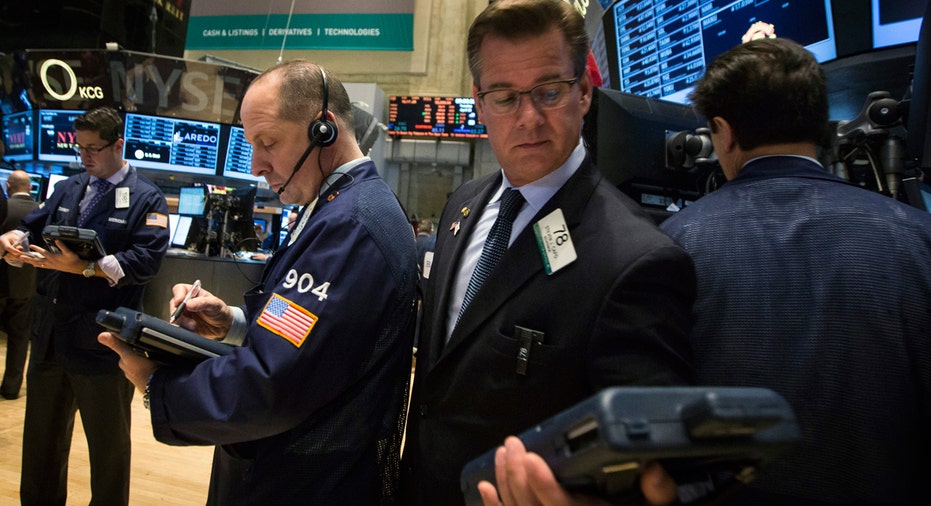Wall Street Ends Mixed on Heels of Rate Decision

U.S. equity markets bobbed between gains and losses – as the Dow saw a 294-point swing during the session – following the Federal Reserve’s decision to hold rates near zero.
The Dow Jones Industrial Average was 64 points lower, or 0.39% to 16675. The S&P 500 declined 5 points, or 0.26% to 2016, while the Nasdaq Composite added 4 points, or 0.10% to 4893.
The utilities and health care sectors each popped during the session, while financials sank more than 1%.
Today’s Markets
Months of speculation about whether September was the month in which the Federal Reserve would begin to lift short-term interest rates finally came to a close. On Thursday the Federal Open Market Committee said it will keep rates near zero rather than opt to hike them for the first time in nine years from historic lows during the Great Recession.
Federal Reserve Chief Janet Yellen explained the committee’s decision following the announcement at a press conference.
"We reviewed developments in all important areas of the world, but we're focused particularly on China and emerging markets," she said.
David Joy, Ameriprise Financial chief market strategist, said the muted market reaction came as a surprise, but the Fed’s decision did not.
“It felt as though once the markets became volatile in the wake of the Chinese currency devaluation, that was enough to cause the Fed to stay on hold,” he explained. “Minutes from the last meeting said the committee was watching international developments in China – at the time they were referring to the market decline before the currency move. If that was on their radar back then, the new information with market volatility spikes and a lot of outside voices encouraging the Fed to stay on hold, made sense for the m not to move.”
Opinions on the Street, while once firmly rooted in the September liftoff camp, were mixed ahead of the decision. Some of the biggest banks, including Goldman Sachs (NYSE:GS) and Barclays, had already shifted out their original calls, and are now looking for an increase to come in December and March, while other forecasts are for a rate hike somewhere in the middle.
Weighing on sentiment was concerns about growth in China, the world’s second-largest economy, after it twice devalued the yuan, its currency, sending global markets into a tailspin. Added to that was a mixed picture for the Fed’s dual mandate of full employment and price stability: Recent data suggests the labor market has firmed, but inflation was far from the central bank’s 2% target.
It’s the inflation picture that Joy said the Fed is likely to be keenly focused on heading into the final two FOMC meetings of the year.
“What’s interesting about the statement is they talk about watching international developments, but they talk at length about inflation and obviously they feel okay with the labor market situation, but they’re not comfortable with the inflation situation,” Joy said. “It looks like they’re concerned about how weakness overseas could put downward pressure on U.S. inflation.”
To that point, the central bank revised down its core PCE inflation projection – or the measure of prices consumers pay for goods and services excluding food and energy. The projection was revised up slightly to 1.4% from 1.3% at the Fed’s June meeting. The central bank also revised down its forecast for the U.S. unemployment rate from 5.3% to 5%.
After the announcement, the yield on the benchmark 10-year U.S. Treasury bond declined 0.061 percentage point to 2.244%. Yields move in the opposite direction of prices.
The bottom line, according to Joy, the Fed is short on options.
“[Yellen] is running out of time. She’s running out of reasons to raise rates if inflation stays as subdued as it is and the global economy continues to remain sluggish,” he said.
Monthly Economic Data, Commodities Reaction
Traders had the opportunity digest a deluge of fresh economic data ahead of the decision. The Commerce Department released the latest figures on starts of new home construction and permits to build new homes in August. Housing starts dropped 3% during the month to an annualized rate of 1.13%, while permits rose 3.5% to an annualized rate of 1.17 million units.
Weekly jobless claims data was also out ahead of the bell. The number of Americans filing for first-time unemployment benefits fell last week to264,000 from an unrevised 275,000 the week prior.
The Philadelphia Federal Reserve’s gauge of mid-Atlantic manufacturing activity plunged in September to -6 from 8.3 in August. Wall Street had anticipated a much shallower decline to 6.
In commodities, crude oil prices wavered after skyrocketing in the prior session on the heels of inventory data from the EIA, which showed a bigger drawdown in U.S. stockpiles than expected. U.S. crude prices on Thursday declined 0.53% to $46.90 a barrel, while Brent, the international benchmark, slipped 1.35% to $49.08 a barrel.
Metals were mixed following the Fed’s decision. Gold lost 0.17% to $1,117 a troy ounce, while silver rose 0.65% to $14.98 an ounce. Copper traded was unchanged at $2.46 a pound.
The U.S. dollar, meanwhile, was mixed against a handful of global currencies, while the euro rose 0.16% against the greenback.
Global markets capped the session mixed ahead of the Fed’s decision.
China’s Shanghai Composite index fell 2.10%, while Hong Kong’s Hang Seng slipped 0.51% and Japan’s Nikkei added 1.43%.
Over in Europe, the Euro Stoxx 50, which tracks large-cap companies in the eurozone slipped 0.12%. Germany’s Dax gained 0.02%, France’s CAC 40 slid 0.20%, while the UK’s FTSE 100 declined 0.68%.